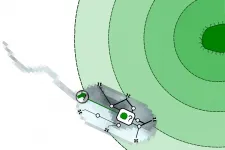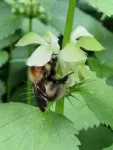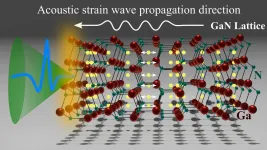Reaching your life goals as a single-celled organism
How do simple creatures manage to move to a specific place? Artificial intelligence and a physical model from TU Wien can now explain this.
2021-05-10
(Press-News.org) How is it possible to move in the desired direction without a brain or nervous system? Single-celled organisms apparently manage this feat without any problems: for example, they can swim towards food with the help of small flagellar tails.
How these extremely simply built creatures manage to do this was not entirely clear until now. However, a research team at TU Wien (Vienna) has now been able to simulate this process on the computer: They calculated the physical interaction between a very simple model organism and its environment. This environment is a liquid with a non-uniform chemical composition, it contains food sources that are unevenly distributed.
The simulated organism was equipped with the ability to process information about food in its environment in a very simple way. With the help of a machine learning algorithm, the information processing of the virtual being was then modified and optimised in many evolutionary steps. The result was a computer organism that moves in its search for food in a very similar way to its biological counterparts.
Chemotaxis: Always going where the chemistry is right
"At first glance, it is surprising that such a simple model can solve such a difficult task," says Andras Zöttl, who led the research project, which was carried out in the "Theory of Soft Matter" group (led by Gerhard Kahl) at the Institute of Theoretical Physics at TU Wien. "Bacteria can use receptors to determine in which direction, for example, the oxygen or nutrient concentration is increasing, and this information then triggers a movement into the desired direction. This is called chemotaxis."
The behaviour of other, multicellular organisms can be explained by the interconnection of nerve cells. But a single-celled organism has no nerve cells - in this case, only extremely simple processing steps are possible within the cell. Until now, it was not clear how such a low degree of complexity could be sufficient to connect simple sensory impressions - for example from chemical sensors - with targeted motor activity.
"To be able to explain this, you need a realistic, physical model for the movement of these unicellular organisms," says Andreas Zöttl. "We have chosen the simplest possible model that physically allows independent movement in a fluid in the first place. Our single-celled organism consists of three masses connected by simplified muscles. The question now arises: can these muscles be coordinated in such a way that the entire organism moves in the desired direction? And above all: can this process be realised in a simple way, or does it require complicated control?"
A small network of signals and commands
"Even if the unicellular organism does not have a network of nerve cells - the logical steps that link its 'sensory impressions' with its movement can be described mathematically in a similar way to a neuronal network," says Benedikt Hartl, who used his expertise in artificial intelligence to implement the model on the computer. In the single-celled organism, too, there are logical connections between different elements of the cell. Chemical signals are triggered and ultimately lead to a certain movement of the organism.
"These elements and the way they influence each other were simulated on the computer and adjusted with a genetic algorithm: Generation after generation, the movement strategy of the virtual unicellular organisms was changed slightly," reports Maximilian Hübl, who did many of the calculations on this topic as part of his Master's thesis. Those unicellular organisms that succeeded best in directing their movement to where the desired chemicals were located were allowed to "reproduce", while the less successful variants "died out". In this way, after many generations, a control network emerged - very similar to biological evolution - that allows a virtual unicellular organism to convert chemical perceptions into targeted movement in an extremely simple way and with very basic circuits.
Random wobbling movement - but with a concrete goal
"You shouldn't think of it as a highly developed animal that consciously perceives something and then runs towards it," says Andreas Zöttl. "It's more like a random wobbling movement. But one that ultimately leads in the right direction on average. And that's exactly what you observe with single-celled organisms in nature."
The computer simulations and algorithmic concepts recently published in the renowned journal PNAS prove that a minimal degree of complexity of the control network is indeed sufficient to implement relatively complex-looking movement patterns. If the physical conditions are correctly taken into account, then a remarkably simple internal machinery is sufficient to reproduce in the model exactly those movements that are known from nature.
INFORMATION:
Contact
Dr. Andreas Zöttl
Institute for Theoretical Physics
TU Wien
andreas.zoettl@tuwien.ac.at
[Attachments] See images for this press release:

ELSE PRESS RELEASES FROM THIS DATE:
2021-05-10
The morphological compatibility between flowers and insects was given in the famous textbook example of Darwin's orchids and hawkmoths. As in this example, many studies have shown that geographical variations in flower size match the size of insects in each region. In other words, studies have shown "flower-sized regional adaptation" in which large flowers evolve in areas pollinated by large insects and small flowers evolve in areas pollinated by small insects.
However, when examining the genetic similarity between populations, are plants in each region more similar, or are plants with large ...
2021-05-10
A team of researchers at the Institute of Laser Engineering, Osaka University, in collaboration with Bielefeld University and Technical University Braunschweig in Germany, came closer to unraveling the complicated optical response of wide-bandgap semiconductor multiple quantum wells and how atomic-scale lattice vibration can generate free space terahertz emission. Their work provides a significant push towards the application of laser terahertz emission microscopes to nano-seismology of wide-bandgap quantum devices.
Terahertz (THz) waves can be generated by ultrafast processes occurring in a material. By looking at THz emission, researchers have ...
2021-05-10
Point-of-Care UltraSonography (POCUS) deployed during the emergency treatment of patients with acute dyspnea has enormous advantages over standard diagnostic pathways. This is the finding of a joint review conducted by Danube University Krems and MedUni Vienna and recently published in the prestigious Annals of Internal Medicine. It allows serious conditions to be identified more quickly so that appropriate treatment can be initiated.
Working on behalf of the American College of Physicians, a joint study group from MedUni Vienna and Danube University Krems conducted a review of the value of Point-of-Care UltraSonography (POCUS) in patients with acute dyspnea (shortness of breath), with a view to drawing up a practical clinical treatment guideline. ...
2021-05-10
End-of-life circuit boards, certain magnets in disc drives and electric vehicles, EV and other special battery types, and fluorescent lamps are among several electrical and electronic products containing critical raw materials (CRMs), the recycling of which should be made law, says a new UN-backed report funded by the EU.
A mandatory, legal requirement to recycle and reuse CRMs in select e-waste categories is needed to safeguard from supply disruptions elements essential to manufacturers of important electrical and electronic and other products, says a European consortium behind the report, led by the Switzerland-based World Resources Forum.
The CEWASTE consortium warns that access to the ...
2021-05-10
Whether wastewater is full of "waste" is a matter of perspective.
"Why is it waste?" asked Zhen (Jason) He, professor in the Department of Energy, Environmental & Chemical Engineering in the McKelvey School of Engineering at Washington University in St. Louis.
"It's organic materials," He said, and those can provide energy in a number of ways. Then there's the other valuable resource in wastewater.
Water.
He's lab has developed one system that recovers both, filtering wastewater while creating electricity. Results from bench-scale trials were published May ...
2021-05-10
As humans, the weather where we live influences our energy consumption. In climates where weather shifts from hot summers to very cold winters, humans consume more energy since the body has to work harder to maintain temperature.
In much the same way, weather influences microbes such as bacteria and fungi in the soil. Seasonal fluctuations in soil temperature and moisture impact microbial activities that in turn impact soil carbon emissions and nutrient cycles.
Microbes consume carbon as the source of energy. As microbes increase in quantity and activities, they consume more carbon which results in more carbon emissions and vice versa.
In a modeling study published in Global Change Biology on May 10, San Diego State University ...
2021-05-10
DALLAS, May 10, 2021-- Hospitalized COVID-19 patients with impaired first-phase ejection fraction were nearly 5 times more likely to die compared to patients with healthier measures of this early, often undetected sign of heart failure, according to new research published today in Hypertension, an American Heart Association journal. First-phase ejection fraction is a measure of the left ventricular ejection fraction until the time of maximal ventricular contraction.
Cardiovascular risk factors and/or disease have been recognized as COVID-19 risk factors that have a high negative impact on patient outcomes, since early in the SARS-CoV-2 pandemic. Researchers ...
2021-05-10
DALLAS, May 10, 2021 — Managing weight, blood pressure and cholesterol in children may help protect brain function in later life, according to new research published today in the American Heart Association’s flagship journal Circulation. This is the first study to highlight that cardiovascular risk factors accumulated from childhood through mid-life may influence poor cognitive performance at midlife.
Previous research has indicated that nearly 1 in 5 people older than 60 have at least mild loss of brain function. Cognitive deficits are known to be linked with cardiovascular risk factors, ...
2021-05-10
DALLAS, May 10, 2021 — In a small study, researchers found college athletes who contracted COVID-19 rarely had cardiac complications. Most had mild COVID symptoms that did not require treatment, and in a small percentage of those with abnormal cardiac testing, there was no evidence of heart damage on special imaging tests. All athletes returned to sports without any health concerns, according to new research published today in the American Heart Association’s flagship journal Circulation.
In spring 2020, concerns about heart damage, especially inflammation, among athletes with COVID-19 led to recommendations for cardiac screening based on symptom severity before resuming training and competition. The preferred diagnostic test for heart inflammation is an MRI of the heart, ...
2021-05-10
Low levels of serotonin in the brain are seen as a possible cause of depression and many antidepressants act by blocking a protein that transports serotonin away from the nerve cells. A brain imaging study at Karolinska Institutet now shows that the average level of the serotonin transporter increased in a group of 17 individuals who recovered from depression after cognitive behavioural therapy. The results are published in the journal Translational Psychiatry.
"Our results suggest that changes to the serotonin system are part of the biology of depression and that this change is related to the episode rather than a static feature - a state rather than a trait," says the study's last author Johan Lundberg, researcher at the Department of Clinical Neuroscience, ...
LAST 30 PRESS RELEASES:
[Press-News.org] Reaching your life goals as a single-celled organism
How do simple creatures manage to move to a specific place? Artificial intelligence and a physical model from TU Wien can now explain this.



